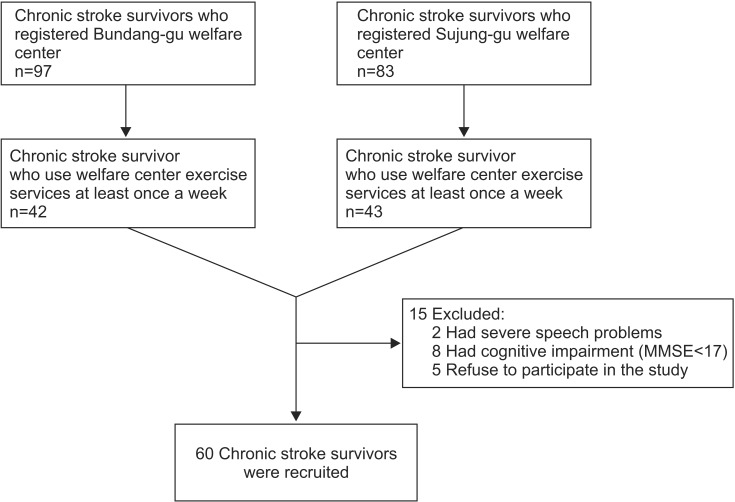Ann Rehabil Med.
2015 Apr;39(2):234-242. 10.5535/arm.2015.39.2.234.
Participation in Leisure Activity and Exercise of Chronic Stroke Survivors Using Community-Based Rehabilitation Services in Seongnam City
- Affiliations
-
- 1Department of Rehabilitation Medicine, Bundang Jesaeng General Hospital, Seongnam, Korea. zeus2se@gmail.com
- KMID: 2273045
- DOI: http://doi.org/10.5535/arm.2015.39.2.234
Abstract
OBJECTIVE
To clarify how participation in leisure activities and exercise by chronic stroke survivors differs before and after a stroke.
METHODS
Sixty chronic stroke survivors receiving community-based rehabilitation services from a health center in Seongnam City were recruited. They completed a questionnaire survey regarding their demographic characteristics and accompanying diseases, and on the status of their leisure activities and exercise. In addition, their level of function (Korean version of Modified Barthel Index score), risk of depression (Beck Depression Inventory), and quality of life (SF-8) were measured.
RESULTS
After their stroke, most of the respondents had not returned to their pre-stroke levels of leisure activity participation. The reported number of leisure activities declined from a mean of 3.9 activities before stroke to 1.9 activities post-stroke. In addition, many participants became home-bound, sedentary, and non-social after their stroke. The most common barriers to participation in leisure activities were weakness and poor balance, lack of transportation, and cost. The respondents reported a mean daily time spent on exercise of 2.6+/-1.3 hours. Pain was the most common barrier to exercise participation.
CONCLUSION
Chronic stroke survivors need information on leisure activities and appropriate pain management.
Keyword
MeSH Terms
Figure
Reference
-
1. Granger CV, Sherwood CC, Greer DS. Functional status measures in a comprehensive stroke care program. Arch Phys Med Rehabil. 1977; 58:555–561. PMID: 597021.2. Kwon HK, Oh CH. Clinical study of stroke. J Korean Acad Rehabil Med. 1984; 8:83–91.3. Lee KM. Rehabilitation treatment of C.V.A. J Korean Acad Rehabil Med. 1977; 2:84–86.4. Dikmen S, Machamer J, Miller B, Doctor J, Temkin N. Functional status examination: a new instrument for assessing outcome in traumatic brain injury. J Neurotrauma. 2001; 18:127–140. PMID: 11229707.
Article5. Wise EK, Mathews-Dalton C, Dikmen S, Temkin N, Machamer J, Bell K, et al. Impact of traumatic brain injury on participation in leisure activities. Arch Phys Med Rehabil. 2010; 91:1357–1362. PMID: 20801252.
Article6. Rimmer JH. Use of the ICF in identifying factors that impact participation in physical activity/rehabilitation among people with disabilities. Disabil Rehabil. 2006; 28:1087–1095. PMID: 16950739.
Article7. Geyh S, Cieza A, Schouten J, Dickson H, Frommelt P, Omar Z, et al. ICF Core Sets for stroke. J Rehabil Med. 2004; (44 Suppl):135–141. PMID: 15370761.
Article8. Alguren B, Lundgren-Nilsson A, Sunnerhagen KS. Facilitators and barriers of stroke survivors in the early post-stroke phase. Disabil Rehabil. 2009; 31:1584–1591. PMID: 19479517.9. Kosinski M, Dewey JE, Gandek B. How to score and interpret single-item health status measures: a manual for users of the SF-8 health survey. Lincoln, RI: QualityMetric Inc.;2001.10. Kinney WB, Coyle CP. Predicting life satisfaction among adults with physical disabilities. Arch Phys Med Rehabil. 1992; 73:863–869. PMID: 1387523.11. Teasdale TW, Engberg AW. Subjective well-being and quality of life following traumatic brain injury in adults: a long-term population-based follow-up. Brain Inj. 2005; 19:1041–1048. PMID: 16263647.
Article12. Jongbloed L, Morgan D. An investigation of involvement in leisure activities after a stroke. Am J Occup Ther. 1991; 45:420–427. PMID: 2048623.
Article13. Parker CJ, Gladman JR, Drummond AE, Dewey ME, Lincoln NB, Barer D, et al. A multicentre randomized controlled trial of leisure therapy and conventional occupational therapy after stroke. Clin Rehabil. 2001; 15:42–52. PMID: 11237160.
Article14. Nour K, Desrosiers J, Gauthier P, Charbonneau H. Impact of a home leisure educational program for older adults who have had a stroke (home leisure educational program). Ther Recreat J. 2002; 36:48–64.15. Specht J, King G, Brown E, Foris C. The importance of leisure in the lives of persons with congenital physical disabilities. Am J Occup Ther. 2002; 56:436–445. PMID: 12125833.
Article16. Parker CJ, Gladman JR, Drummond AE. The role of leisure in stroke rehabilitation. Disabil Rehabil. 1997; 19:1–5. PMID: 9021278.
Article17. Desrosiers J, Bourbonnais D, Noreau L, Rochette A, Bravo G, Bourget A. Participation after stroke compared to normal aging. J Rehabil Med. 2005; 37:353–357. PMID: 16287666.
Article18. Jette AM, Keysor J, Coster W, Ni P, Haley S. Beyond function: predicting participation in a rehabilitation cohort. Arch Phys Med Rehabil. 2005; 86:2087–2094. PMID: 16271553.
Article19. Kim SH, Byeon YC, Sohn CG, Lee YH, Lee MK, Lee SH, et al. 2011 Survey of the Disabled. Korea Institute for Health and Social affiars.20. Rimmer JH, Wang E, Smith D. Barriers associated with exercise and community access for individuals with stroke. J Rehabil Res Dev. 2008; 45:315–322. PMID: 18566948.
Article21. Shaughnessy M, Resnick BM, Macko RF. Testing a model of post-stroke exercise behavior. Rehabil Nurs. 2006; 31:15–21. PMID: 16422040.
Article22. Hansen AP, Marcussen NS, Klit H, Andersen G, Finnerup NB, Jensen TS. Pain following stroke: a prospective study. Eur J Pain. 2012; 16:1128–1136. PMID: 22407963.
Article23. Jonsson AC, Lindgren I, Hallstrom B, Norrving B, Lindgren A. Prevalence and intensity of pain after stroke: a population based study focusing on patients' perspectives. J Neurol Neurosurg Psychiatry. 2006; 77:590–595. PMID: 16354737.
Article24. Kim BS. Development of medical rehabilitation system for persons with disabilities. J Korean Acad Rehabil Med. 2004; 28:1–6.
- Full Text Links
- Actions
-
Cited
- CITED
-
- Close
- Share
- Similar articles
-
- Causes and Trends of Disabilities in Community-Dwelling Stroke Survivors: A Population-Based Study
- Exercise Participation Experiences of Colorectal Cancer Survivors
- Stroke Rehabilitation Fact Sheet in Korea
- Monitoring Step Activity During Task-Oriented Circuit Training in High-Functioning Chronic Stroke Survivors: A Proof-of-Concept Feasibility Study
- Social Support and Health Status based on Characteristics of Leisure Activity of Middle-Aged Women


